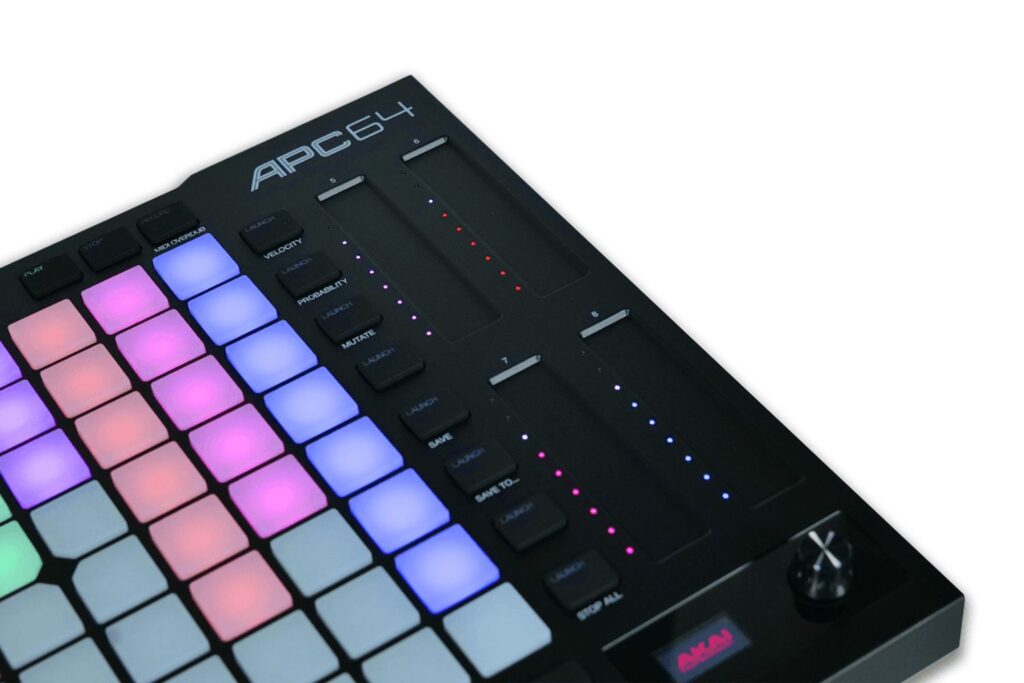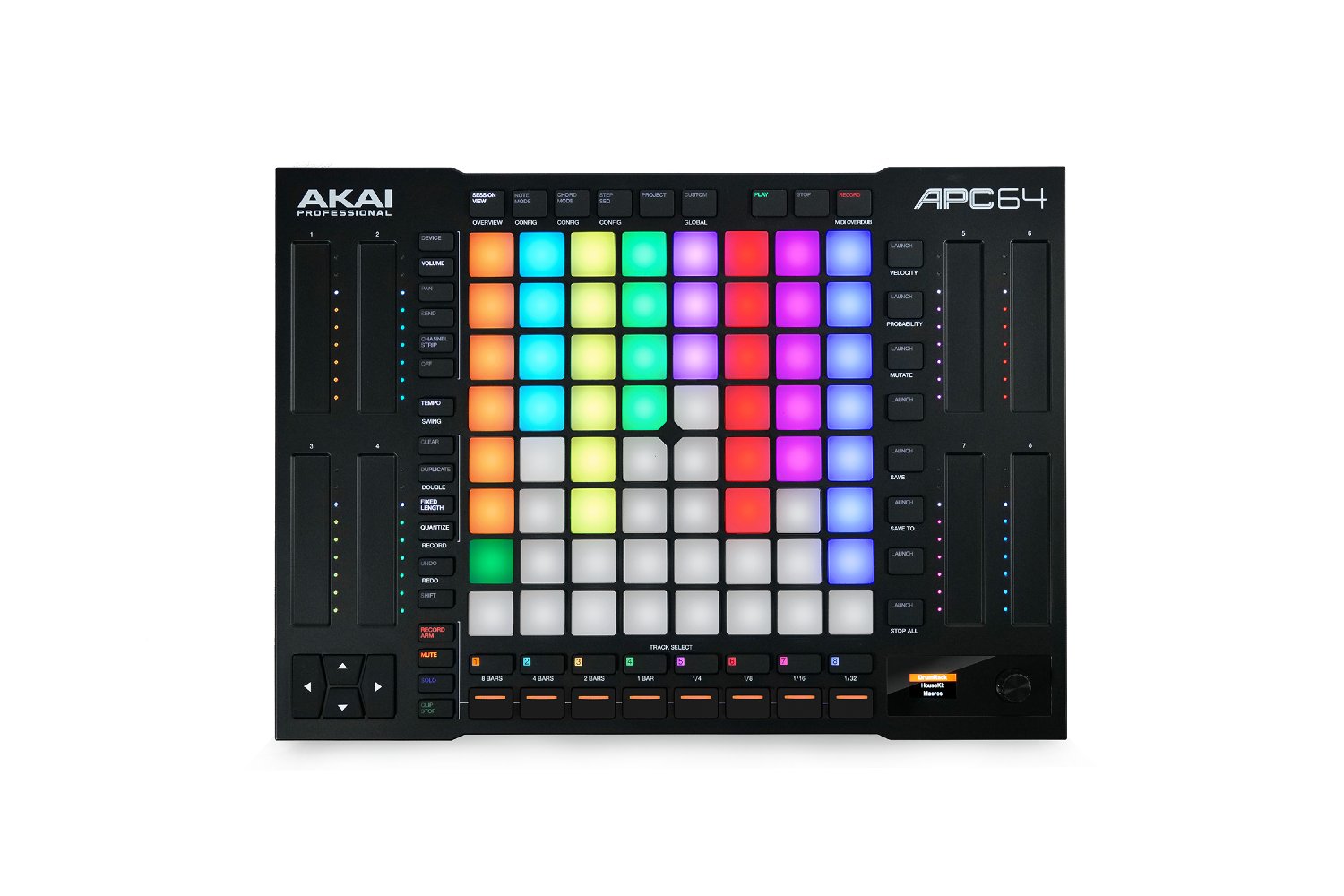Akai APC64 Ableton Controller | Electric Factory | RRP $649
When Ableton Live first came to market, it changed the way in which many music producers went about the process of interacting with their DAW. Then, with the advent of controller interfaces purpose built for use with this software platform, it all went a little further to creating a seamless interaction between human and machine. This dedicated hardware availability all started happening a little over ten years ago. And in that time, we’ve seen products that ‘wowed’ us get transformed and refined into products that worked with us. That brings us to this very special piece of kit I had the pleasure of going over this month, the all-new Akai APC64 Ableton Controller. This is the hardware interface that is going to bring your computer and your hardware synths together, and allow them to work apart too.
Akai APC64
So, the 64-pad controller concept is by no means a new breakthrough. We’ve seen it used as a basis of Ableton control surfaces since they first originated. Furthermore, we’ve seen similar concepts in the early Akai MPC desktop samplers with the 16-pad format for use triggering samples and programming sequences. So, we’ll all be familiar with this layout. These are RGB backlit pads, that change colour with activation and function, offering velocity sensitivity and aftertouch too, which is a standard we’ve come to expect on any controller pad nowadays. Each side of this pad section features a series of function buttons, that allow you to engage a wide variety of Ableton features, without the need to go to your mouse or computer keyboard.
Read more gear reviews here.
Ableton controller
Dedicated transport controls found in the top right, and Mute/Solo/Record Arm controls are in the bottom left, adjacent to the track selection buttons, so you can bounce from the specific function to the necessary track with the least amount of movement. There’s a host of more in-depth function buttons found on either side of the pads, like the ever essential Undo and Redo buttons, as well as a range of tempo and quantize control buttons, and a series of Ableton specific function buttons. It all sits nicely in the confines of a workspace that accommodates two hands working in unison.
Then, Akai have included 8 fully assignable Touch Strip controllers, to bring expression and to record movement to your recordings. What I love about these is the placement. So often, we’ll see a bank of similar strips on a controller, with them all laid out side by side, emulating a mixing console’s bank of faders. But, being assignable, it can be a bit confusing as to what strip is doing what function when they are all in a row. That’s why we used white masking tape and a Sharpie on the mixing consoles, to mark up the fader assignments, and often banked channels with spaces in between for clarity. So, with that sort of thinking, Akai have very cleverly placed four on either side of the pads, with two above the other two. This places the eight Touch Strips into two banks of two rows with two faders per row. That makes it super simple for allocating processes to the controllers and keeping them where you can remember. I know, it sounds pretty simple, but when you want a fast workflow, and the ability to know where everything is without having to scrutinize labels, this allocation of the Touch Strips is genius.
DAW controller & step sequencer
Of course, this unit is built with the express function of controlling Ableton software, but it goes one step further. This is a big plus for the APC64 and, given the recent renaissance in analogue hardware synthesizers, it’s a feature that the team at Akai should be quietly patting themselves on the back for. The APC64 is not just a DAW controller, but offers a built in sequencer too. We all know that there are huge benefits to harnessing the power of a DAW in your music creation to speed up workflow and introduce vast arrays of sounds, effects and features. But, there is something special, something a little more organic about creating music without being tethered to the computer all the time. So, Akai have enabled just such a process with the APC64. By powering the unit with the USB connection, it can run as a standalone sequencer for your hardware synths and drum machines. The APC64 offers eight physical CV/Gate outputs, as well as one MIDI input and two MIDI outputs. These are all supplied on 3.5mm mini-jack connections, the MIDI ports requiring a 5-pin DIN adapter to interface with most hardware units. This now opens up a whole world of possibilities, especially for live performance when you don’t want to be reliant on a computer, and would prefer to control your mix from just a hardware setup. For greater ease of use, you can use the software editor when the APC64 is connected to your computer to build and edit sequences to be stored in the unit for standalone use.

Bundled up with a copy of Ableton Live Lite, just in case you’re yet to commit to the full software package. And if you haven’t, what’s keeping you? There is so much expressive power in the creative tools offered in Ableton, you’ll want to jump into the full Suite sooner rather than later. Also included with the APC64 is a bundle of Air Instruments to help get your music making underway. This is backed with more than 1GB of loops and samples.
So, if you’re a seasoned Ableton user, a synth geek looking to gain better control with DAW integration, or a beginner in the realm of electronic music making, this unit is going to get you on top of your game with an intuitive layout that speeds up workflow and aids the creative process. If you’ve not seen one in action, go and check out the Akai APC64 Ableton Controller at your local Akai dealer today. Or tomorrow. Or this weekend. The sooner you do it, the sooner you can get it home and start making better music!
For local enquiries, visit Electric Factory.

